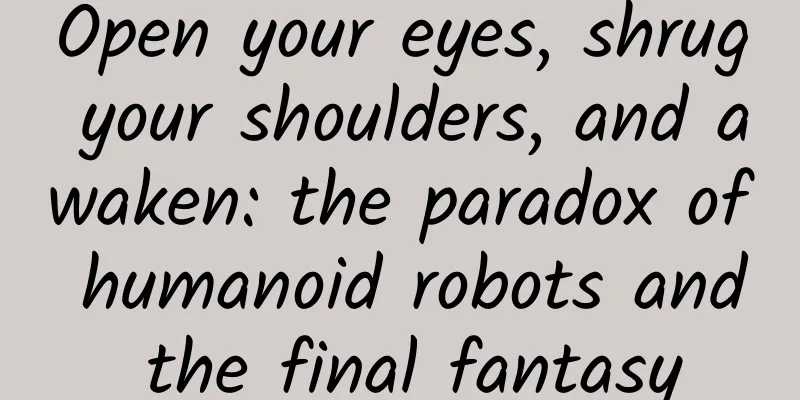Open your eyes, shrug your shoulders, and awaken: the paradox of humanoid robots and the final fantasy

|
The most terrifying thing recently is the humanoid robot made by a British company. From the moment the robot raises its eyes to the moment it stretches its body and five fingers, every movement is accompanied by precise expression management, which is so scary that people can't hold back. It feels like the soul is imprisoned in the machine, observing and digesting what is happening in the real world. It's very strange. I wonder what you think after watching it? This robot is called Ameca and comes from a British technology company Engineered Arts. Compared with the Sophia robot, Ameca's expressions are very natural and more refined, and it can make realistic expressions like blinking, staring, thinking, etc. This kind of lifelike and curious humanoid robot hits the bull's eye of our curiosity, and many people watch it several times. However, the consequences of this operation may lead to some new stories. For example, the sequelae of dream face. The weird thing is that this robot is more three-dimensional and breathtaking after it appears in the dream. In the past two days, my dreams are all about this kind of green-faced bald man, wearing a black cloak, just like the setting of the Dementors in Harry Potter, floating in front of you suddenly, making a messy expression and scaring you half to death. I have been awakened in the middle of the night for several consecutive days, and now I can only fall asleep with a night light on. Ameca has successfully penetrated into the subconscious and is the new nightmare fuel. Whether the release of this kind of curious humanoid robot attracts people's attention or leaves people with huge imagination space, it also gives people room to play with their subconscious mind. Why does the face of a humanoid robot bring such great attraction and lethality? What exactly are we afraid of in robots? The scariest thing is the human face? What attracts our attention on social networks is the realistic face of the robot, but we seem to be frightened by this machine that looks like a human. Behind this is actually a common psychological phenomenon among the public - the uncanny valley effect. This effect was proposed by Japanese roboticist Masahiro Mori. He named this psychological phenomenon the "uncanny valley" effect based on the psychological change of human beings from liking to extremely disgusting to highly anthropomorphic humanoid robots in a certain similarity range. In fact, when it comes to these highly realistic robots, on the one hand, we admire the progress of technology because of the fancy gimmicks of these technologies. On the other hand, these humanoid robots that look so similar to humans trigger a physiological aversion to "non-human" things. The root of this may be the instinctive defense mechanism of projecting the fear of the unknown onto these images. With the development of artificial intelligence technology, machines have learned how to imitate and play chess in the process of copying humans, and can even control their limbs to balance like humans to perform fancy gymnastics or street dance. The ability to control limbs can easily attract the admiration and emotion of countless eyes, and the human-like expressions and speech skills give people more room for imagination. In countless science fiction books and movies, such as the familiar science fiction robot movies "Terminator" series, "Westworld", or the philosophical "Love, Death, Robots", the content of these popular science fiction movies has also influenced people's views on robots, the dualism of good and evil of machines, robots replacing humans, or robots rising up to resist and enslave humans, these unknown fears are all factors that trigger our defense mechanisms. When the robot's face is highly similar to that of a human, it also sends a message to our brain, allowing it to quickly pay attention to and understand information related to survival. Humans have an innate ability to recognize "faces", which is actually a survival protection mechanism. The expressions of the same kind are an obvious signal to understand the current situation. For example, if you can quickly find a face in the wilderness and interpret the information of the face to decide the next action, it is a very important survival method. In fact, the speed at which the human brain recognizes a face from a visual image is faster than the conscious activity. This gives humans plenty of time to perceive danger in survival and evolution. When we focus on the features of humanoid robots on their faces, the rich expressions are just pre-set program codes for the machines. The lifelike performances bring more mirror projections and fears to people's minds. We are very good at seeing the image features of humans from inanimate objects, especially faces. This may be an externalized function of humans being too obsessed with themselves. It may even inspire some imaginations about the relationship between the body and the soul. To some extent, humans are also a kind of limitation imprisoned in the flesh, and this idea is also triggered by the facial perception of humanoid robots. We always want to interpret things that belong to human will from various physical phenomena, and then label, differentiate, exclude, and fear it from the perspective of survival and interests. There are essentially two psychological reasons why humans are afraid of robots: one is that they are afraid that intelligent robots will replace them as labor, and the other is that they are afraid that robots will have consciousness and will rise up to enslave humans. From the perspective of these two fears, the dimension of the substitutability of external image and ability clearly has the uncanny valley effect. For the inner mental level, the consciousness of humanoid machines is also within the scope of the projection of the uncanny valley effect. The Ambition of Intelligence and Consciousness Regarding robot consciousness, many companies like to cater to the public's tastes and take unconventional approaches when promoting their products. For example, when the Sophia robot was released, it boasted that it would destroy humanity. After being attacked repeatedly by researchers, the Boston Dynamics robot finally fought back. Although the official finally admitted that the video was staged, it still gave many people the impression that robots will fight back and destroy humans after they gain consciousness. In fact, robots are not as smart as people imagine, and they are even a little mentally retarded. The chattering robots we see on the market are all controlled by humans in the background, or the words are set by the staff in advance. Robots are not smart enough to communicate with people naturally. If we judge the natural language processing ability of robots, it is basically at the level of smart speakers on the market, and it is still some distance away from the intelligent stage of autonomous cognitive analysis and reasoning, let alone super artificial intelligence with self-awareness. The Ameca robot designed by the British company is also average in intelligence. Its rich expressions are realized by the digital expression model designed in-house, and its operation is supported by the underlying simulated humanoid robot system. The Ameca robot is equipped with a variety of sensors, including cameras, microphones, position encoders, and thousands of smart devices, and the data of these sensors can be obtained in real time. Finally, Ameca can realize actions such as staring at others and entering into simple conversations. Every time a humanoid robot with a lot of hype comes out, it will bring a wave of impact and discussion. Some time ago, Musk's humanoid robot came out and attracted a lot of attention. In fact, the so-called third-generation artificial intelligence is still in the stage of simulating the most basic human perceptual intelligence. The visual ability has made great progress, but other cognitive abilities, especially the advancement of thinking consciousness, are still in the difficult climbing process. The higher-level general artificial intelligence with comprehensive reasoning and judgment capabilities is even more distant, and super artificial intelligence with self-awareness is just a drama and imagination. However, even though we know this fact and know that these things are "fake", we still regard them as "intelligent" products. When faced with certain scenarios, we can't help but produce the logical deduction that "robots will rise and destroy humanity", and the root cause lies in the instinctive fear of factors that threaten our survival. According to the law of human survival, once AI with "self-awareness" appears, it will definitely control or eliminate humans, the "other" subject that can control the right of AI to survive. These a priori judgments exist in human blood and genes, and have protected human reproduction over millions of years of evolution. This also constantly reminds humans that once some suspicious signals appear, such as "human-like" robots, the brain will immediately sound an alarm. The uncanny valley effect has a great impact on our external image and internal consciousness, and also affects the space and dimension of our research and creation of AI. Humanoid robot final fantasy Judging from the capabilities of the Ameca robot, at least at this stage, it is still not accepted by the public as a home service robot. Suddenly, a humanoid robot with a human face appeared in the house. The degree of simulation is very similar to that of a human, and it can talk to people. Suddenly waking up in the middle of the night, a non-human humanoid shadow talks to you. It can really scare people to death. It's a bit weird no matter how you think about it. Some netizens commented on Ameca's expression, saying that the more human-like it is, the scarier it is. It may be easier to accept if it is made into a cartoon or animal image. So, what should the future of humanoid robots look like to be more popular? Ameca robots will be very popular with film and television and game companies in the future. They can reproduce the characters of many classic IPs or smart peripherals. Under the premise of the characters of classic IPs, it should be easier for the public to accept such humanoid robots. It is good to put them in company promotions or supermarkets to attract people. As for whether to put them at home, it depends on the situation. For some basic and simple service positions, humanoid robots will also be very useful, such as toll booths at highway intersections and toll halls for various payment. They provide uniform smiles and services, without emotional slackness and impatience, and are peaceful. For relatively complex business, they are handed over to humans to handle, and machines and humans work together to maintain the normal operation of the business. Aging and population crisis are already established realities. Humanoid robots, as nursing machines or caregivers for special groups, are the most promising development industry. There is no filial son in front of a long-term sick bed. For things that require huge energy investment, such as caring for patients and the elderly, it is more reassuring to entrust them to sufficiently intelligent robots. The market can provide two types of services: leasing and exclusive sales, and everyone can take what they need. For our generation, it is very likely to catch up with robot elderly care. Letting robots with standard services, patience, and no negative emotions to take care of the elderly is also a relatively good choice. Work hard and move bricks well, so that you can rent a high-level robot to work in the future. The development direction of these humanoid robots mentioned above is already the goal of the industry and enterprises, and is in the process of continuous evolution. In addition to these directions at the material and physiological levels, some people have bigger brains at the consciousness level. The ultimate fantasy of humanoid robots is to live forever as a carrier of human consciousness. Just like the situation described in the Black Mirror series or "Love, Death and Robots", when humans die physically, the human neural network will be digitally reconstructed, and finally the packaged consciousness will be extracted and transplanted to the machine, and the body will continue to exist. In ancient times, there were Taoist elixirs to maintain immortality. In the intelligent age, we may also use machines to keep consciousness immortal. This trend is also a more interesting setting. Our generation cannot catch up with the possibility of seeing it, but it may be realized in a few hundred years. Inferring from the functions set by robots, we see that these development possibilities serve humans very well. However, in the intelligent era, how can we face the "uncanny valley" psychology at the mental level and live in harmony with machines in the projection of crisis awareness? This is a key issue that humans and AI machines cannot avoid in the future. From the perspective of anthropocentrism, we very much hope that we can transcend the limitations set for us by natural evolution. For the intelligent species we create, we hope that they have unlimited imagination, but we also want them to develop within the established rules and limitations. From this perspective, the development of intelligent robots will grow under limited rules. Just like all controversial emerging things, they will experience doubts, chaos, and infinite evolution. But between limited rules and unlimited growth, there are also infinite blind spots. In the middle may be the singularity of the awakening of human and machine consciousness, so the ultimate evolution in the future is possible in any direction... |
<<: Throw all the seeds into the water, and you will know which one is left by the ancients.
Recommend
How to promote and attract new users during the cold start phase of APP?
As the threshold for APP development is lowered, ...
[Practical Information] Information flow advertising landing page treasured by people from all industries!
We all know that the task of most landing pages i...
The inedible "tree lobster" survives on an isolated island
Lord Howe Island is a volcanic island located bet...
How does a wedding photo studio promote itself on Weibo? How effective is Fantong?
The development of the Internet has brought a con...
11 ways to increase product conversion rate!
Improving conversion rate is one of the core task...
APM: Let you see the application at a glance
The golden rule of IT application design and deve...
Distribution and MLM are indispensable for user growth and fission
In the author's nearly five-year career in us...
What is your chance of encountering Aurora? This index is the key
Since 2019, the sun has entered its 25th activity...
Xu Jiaxi from Unicorn Think Tank: In-depth report on the ventilator industry
Source: Unicorn Think Tank Source: Industrial Sec...
Musk: Tesla's electric pickup Cybertruck is about to roll off the production line, with reservations exceeding 500,000 units
Recently, a netizen asked Musk on Twitter when Te...
Jack Ma's automotive ambition: buying, selling, washing and repairing cars
Everyone knows that BAT is eyeing the automotive ...
China's Sky Eye is amazing! The "identity card" of repeated fast radio bursts has been found
◎ Science and Technology Daily reporter Lu Chengk...
Sand onion, a vegetable blind spot for southerners
If you were asked to quickly list the ingredients...
Don't buy this kind of fertilizer online to grow plants! Some people got seriously ill and almost died because of it
They accidentally came into contact with the fece...
10 strategic indicators on how to quickly increase the volume of advertising!
This article will introduce in detail the specifi...

![[Tools] Recommend 8 promotion and operation tools commonly used by experts, you must know!](/upload/images/67cc3e082b7c5.webp)







